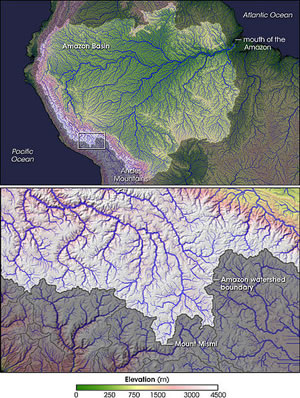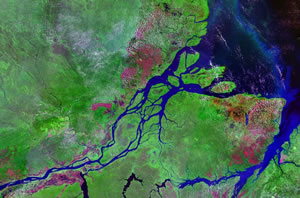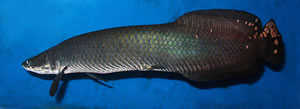The Amazon has the greatest volume of water of all the rivers on Earth.
More than 1,100 tributaries, 17 of which are longer than Europe's Rhine, feed the Amazon's main trunk with storm water and melted water from the surrounding mountains.
At any moment, the Amazon and all its tributaries contain two thirds of all the Earth's river water.
 The Amazon's volume is so large that it pushes back the Atlantic's saltwater for more than 160km (100mi), creating a huge freshwater lake.
The Amazon's volume is so large that it pushes back the Atlantic's saltwater for more than 160km (100mi), creating a huge freshwater lake.
In a single day, the Amazon releases into the Atlantic the same volume of water that is disgorged by England's River Thames in a year.
Lake Lauricocha is the source of the Amazon. This lake lies in the Peruvian Andes, 5,180m (17,000ft) above sea level
The Amazon flows for 6,440km (4,000mi) from this lake to the Atlantic. It is second longest river in the world, after the Nile.
For the 4,800km (3,000mi) from the foothills of the Andes to the Atlantic, the forest-covered Amazon basin never rises more than 198m (650ft) above sea level. The basin is so flat that the river gradient is rarely more than 2.5cm (1in) in every 1.6km (1mi).
 The Rio Negro is the Amazon's greatest tributary. Its waters are black, as indicated by its name.
The Rio Negro is the Amazon's greatest tributary. Its waters are black, as indicated by its name.
The Rio Negro's blackness comes from an acid from the rotting vegetation of the Colombian swamps where the river draws much of its water.
At Manaus, where it meets the white waters of the River Solimões to form the Amazon proper, the Rio Negro is 18km (11mi) wide. The two rivers flow so quickly that they do not truly merge for 6km (4mi).
From Manaus, the Amazon still has a third of its course to run. As it approaches the Atlantic coast, it splinters into channels, the main channel being 50km (30mi) broad, and creates a multitude of islands.
Marajó, the largest of these islands, is about the size of Switzerland.
Life in the Amazon
The Amazon is renowned for its varied and abundant wildlife.
The creatures of the Amazon held a particular attraction for British naturalists of the Victorian era.
In the early 1850s, Alfred Russel Wallace made discoveries in the Amazon jungles in the early 1850s led him to the same theory of evolution by natural selection as his fellow scientist Charles Darwin.
Between 1848 and 1859, Henry Bates collected almost 15,000 animal specimens, half of which were entirely new species. At the same time, botanist Richard Spruce collected 7,000 new plant species.
Over 2,500 different species of fish are known to live in the waters of the Amazon, ten times that of all Europe's rivers combined
 The arapaima is one the largest freshwater fish on Earth. It weighs, on average, massive 200kg (4401bs) and can grow to as much as 5m (16.5ft) long. It lives in the river's poorly oxygenated swamp waters.
The arapaima is one the largest freshwater fish on Earth. It weighs, on average, massive 200kg (4401bs) and can grow to as much as 5m (16.5ft) long. It lives in the river's poorly oxygenated swamp waters.
The red-bellied piranha, which only reaches a length of about 30cm (12in), hunts in groups. Piranhas have razor-sharp teeth. They have been known to reduce large, but wounded, animals to a bare skeleton within seconds
Usually, piranhas eat other fish, fruit and seeds.
The black caiman is the Amazon's largest predator. It can grow 4.5m (15ft) long. It is known to have attacked human beings. It usually eats aquatic mammals, such as the manatee, and animals of the forest, such as the capybara and the tapir, when they visit to the river to obtain water to drink.